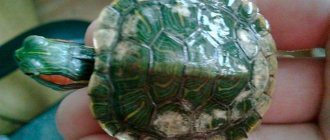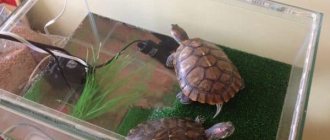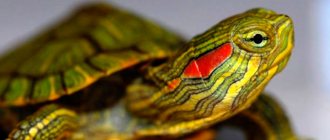Animal feed
It is best to build a diet based on animal food. The reptile's menu consists of 60% or more animal protein .
A turtle will happily eat any meat, but it is preferable to feed it lean varieties: beef, rabbit or poultry .
Attention! It’s a good idea to diversify your pet’s diet with fish, beetles and plants.
Meat
The aquarium red ear eats meat with pleasure, but how to feed it correctly and how many times a day so as not to harm it?
The basis of the diet is necessarily lean meat . Fatty lamb and pork will lead to digestive problems, illness and even death of the pet. In addition to the protein itself, the diet should contain by-products:
- heart;
- liver;
- stomachs.
You can occasionally feed your turtle small mice.
Important! A diet of only unprocessed meat is a direct path to vitamin A deficiency and rickets. You need to diversify the list of products, then your pet will be healthy.
What kind of fish is suitable for food?
What fish should you feed your red ear? As with meat, you need to choose lean varieties. First remove bones that can harm the turtle, as well as entrails and scales.
In addition, before serving, it is recommended to dip the fish in boiling water for a couple of minutes so that the thiaminase enzyme coagulates.
A cocktail made from sea creatures would be a good addition to your diet , but you shouldn’t give it often.
Attention! The redfish will not get along in an aquarium with fish and snails - this is its natural food supply.
Insects
What do red-eared turtles eat besides food? You will be surprised - insects! In summer they add to the menu:
- grasshoppers;
- caterpillars;
- bloodworm;
- mealworm;
- gammarus;
- daphnia (but in this case it is better to turn off the filter for a while).
Other animal food options
You should not feed your turtle caught cockroaches or spiders.
Insects can be “stuffed” with toxic substances, which will certainly harm your pet.
Keeping a red-eared turtle at home
For a pet to live at home, many different accessories are required, some of which are quite expensive. But it all depends on the manufacturer. Below is a list of mandatory things that are necessary for keeping and caring for an animal:
- aquarium;
- 100 Watt water heater;
- filters;
- UV lamp;
- pet heating lamp;
- thermometer;
- lamp;
- island, shore and land.
Components of an aquarium for a turtle
The list is quite impressive, but every detail is necessary.
Aquarium
A pet needs a large aquarium, optimally 200 liters. For a small turtle that has just been purchased and brought home, 10–15 liters will be enough. To avoid unnecessary hassle, it is better to accustom your pet to a large house in advance. This will make it easier for him to swim, since the animal must move and develop its muscular system and not become obese.
The water level must be adjusted so that the pet can stick its muzzle out of the water while standing on its hind legs. If the aquarium is initially deep, you can put a piece of wood or stone on the bottom.
Aquarium for turtle
When choosing soil, pay attention to its size and do not use small stones. In the process of eating and collecting food from the surface, a turtle may get carried away and begin to eat stones, which will lead to death or illness. You also need to be especially careful when choosing algae for your aquarium, because many species, such as Elodea or Ambulia, are poisonous to aquarium reptiles.
Do not use small pebbles to decorate the aquarium, otherwise the turtle may confuse them with food, which will lead to inevitable consequences.
Lamps
In order for a turtle to produce Vitamin D, it needs to be exposed to ultraviolet light. Since there is enough similar lighting in nature, when keeping a turtle at home, it needs to be created. In this case, household lamps will not be useful, since they are difficult to position along the entire length of the aquarium.
Ultraviolet lamp location
The most popular lamp for lighting an aquarium in which reptiles live is Repti Glo 5. For comfortable lighting, you need to place the lamps at a distance of 40–50 cm from each other. Also, lighting and heating play a significant role in the process of metabolism and other functions. If your pet doesn't have enough light and heat, he may hibernate and his activity will decrease.
Island
Pet stores offer a wide selection of aquarium islands to suit every taste and budget. But when buying, be sure to pay attention to the material of manufacture. Also, the main indicator of reliability is the method of attachment to the bottom of the aquarium. For example, good islands have suction cups on the bottom, which help prevent the island from slipping on a wet surface.
But keep in mind that when the turtle grows and its weight reaches 1 kg, the suction cups will constantly come off, and the island will float throughout the aquarium. Therefore, instead of an island, it is better to use a special bridge-platform on which the turtle can climb and move.
Island with suction cups
When installing such a platform, it is necessary to install a ladder to it, which will not interfere with the pet’s swimming in the water. The reptile will sit on it when it is already too hot under the lamp.
Filter and heater
These two important components must be selected based on the volume of the aquarium and the amount of water in it. Modern pet stores offer filters that allow you not to change the water for a very long time. If the filter is placed outside the aquarium, it requires much less maintenance. And you can be sure that the turtle will not accidentally or intentionally remove it from the mount, bite the wire and eat the suction cup. If we talk about the heater, it needs to be set automatically to regulate the water temperature from 21 to 27 C.
You should always monitor the cleanliness of the water in the aquarium. After all, pets sleep, eat and even mate in water. The filter will help make the water cleaner, because dirty water is a source of infection and the spread of bacteria.
Plant food
The diet of an adult turtle should be dominated by plant components . The older she is, the more vegetarian dishes are on the menu.
Grass
Little Reds eat their coltsfoot with gusto. Also great for:
- leaves of plantain, clover, dandelions;
- sprouted oats and barley.
Aquarium plants
Seaweed is a good addition to the menu. Duckweed, watercress and any plants from natural bodies of water are suitable
Vegetables
Turtles love kibble:
- bell peppers;
- zucchini;
- eggplant;
- cucumbers;
- tomatoes;
- carrots;
- beets;
- pumpkins.
Mushrooms
Once a week, champignons, russula or boletus , cut into small pieces, are added to the regular diet.
How often?
And another significant issue for turtle owners is the frequency of feeding. Here, there is no need to focus on how often the red-eared turtle feeds on something, if you do not put restrictions on it - these creatures are not endowed with increased intelligence, and eat as much as food appears within reach.
Therefore, it is recommended to give food to very small turtles a couple of times a day, and to those that have reached adulthood – once every two to three days (but in sufficient quantities).
The volume of food is the size of 2 pet heads.
Between main meat meals, you can feed with plant foods - washed duckweed, pieces of vegetables or fruits. And don’t be afraid to leave your pets hungry – it’s even good for them; overfeeding is much more harmful than underfeeding!
Author - Dasha Blinova, website www.sympaty.net - Beautiful and Successful. This article has been checked and approved by a veterinarian. Knyazeva Anna Vladimirovna, veterinarian in private practice, Moscow. Learn more about the site's authors. Copying this article is prohibited!
Artificial feed
Pet stores generously offer a wide variety of food for turtles , but such mixtures do not cover the reptile’s need for proteins and microelements.
Homemade food
If store-bought food is not suitable for your turtle, you can prepare the food yourself.
Take:
- 50 g cabbage;
- 70 g carrots;
- 150 g lean fish;
- 50 g apples;
- 100 g squid meat.
The products are passed through a meat grinder or crushed with a blender . Add 2 eggs, gelatin (1 tablespoon per 150 ml of water) and 150 ml of milk to the mixture. Mix everything thoroughly and store in the refrigerator for no more than a week.
This amount of food is enough for about 10 servings for one small turtle. Before serving, food is cut into portions.
Is it possible to give turtles dog/cat food?
Although turtles eat commercial cat and dog food with great pleasure, such a diet does not benefit them.
Such mixtures do not contain the microelements necessary for reptiles, and abuse of such a diet will lead to serious health problems for the turtle .
The dangers of overfeeding and underfeeding
Overfeeding a red-eared turtle can cause:
- abnormal growth of young individuals, in which case they have a disproportionately large shell and fragile, small paws;
- obesity in adult reptiles, you can see fat on their sides when they pull their paws into the shell, skin folds that look like bubbles are visible;
- the pyramidality of the shell, in which tubercles can be seen on it; this pathology provokes various diseases of the internal organs of the turtle;
- tympany, in which the reptile does not sink in the water and falls on its right side, undigested food is visible in the feces, it can blow bubbles from its mouth, and vomiting is possible.
Lack of food will lead to exhaustion of the pet, in which skin peels off from the reptile's paws.
This is why it is so important to know how much and how often to feed red-eared turtles.
Vitamin and mineral complexes
Turtles need calcium to form their shell. fill the need for microelements with the help of bone meal - it is mixed into the food.
A pinch is enough for young redears; for older ones, a teaspoon is “stretched” for a week.
In addition, special vitamins for turtles are added in accordance with the instructions, but the shelf life of such food is limited.
How to maintain?
If you want to get this animal, be prepared for the fact that you will have to purchase a separate large aquaterrarium for it. In the summer, she will feel great in the pond, but with the onset of cold weather, she will have to be moved home. Keep in mind: if you want to release a turtle into a pond on your property, this predator will destroy all its inhabitants, including fish and other turtles.
This turtle is insensitive to the composition of water, decor, etc. The main thing it needs is a lot of space and good filtration, since these predators have an excellent appetite and, accordingly, defecate often. Uneaten food left after a meal spoils and the aquarium becomes dirty, which can cause the turtle to get sick.
The snapping turtle needs a shore. In nature, they rarely bask in the sun, but often crawl onto land. It is unlikely that the aquaterrarium is large enough for your pet to crawl along the shore, but she will need a place to warm up sometimes. The aquaterrarium should be equipped with a heating lamp (place it high enough so that the turtle does not overheat) and a UV lamp to absorb vitamin D.
What to give little red ears
A small (under a year old or less than 10 cm in shell) turtle is fed 1-2 times a day .
The amount of food depends on how active the pet is. The volume of the portion is approximately equal to half the shell, but if the turtle does not eat this amount within half an hour, the portion should be reduced.
Reproduction of representatives of the species
Representatives of this species mate from the age of 4 (males) and from 5 years (females). In order for animals to produce offspring in the future, you need to prepare an aquarium in advance. The water level should be at least 10 cm. This is necessary so that the female does not remain without water for a long time during the mating period. Then you need to prepare a dry place where the female will lay eggs in the future.
For proper mating, there should only be one boy and one girl in the aquarium. Otherwise, male turtles will fight, and they do it very aggressively - they bite off each other’s tails and paws. After the female lays eggs, they must be transferred to an incubator - a container with sand. The layout is similar to a chicken incubator. The ideal temperature for egg maturation is 25–27 C. On average, it takes about 5 months for a turtle to be born.
Incubator container
After hatching, the babies should not be allowed into the aquarium with adults, since the latter do not have developed maternal and paternal instincts, and they can attack turtles.
If turtles are properly cared for and feeding recommendations are followed, they will delight their owners for decades.
How does it reproduce?
Unpretentious snapping turtles are ready to mate at any opportunity. In nature, the breeding season begins in the spring, as soon as it gets warmer.
In captivity, the male and female are kept separately, and with the onset of warm weather they are transplanted into the same body of water. We need to watch them so that they do not injure each other. The female has a very strong instinct for reproduction, so watch her doubly carefully: she can even escape from a closed terrarium to lay eggs.
On average, the female lays up to 15 eggs; after 80 days, the young hatch from them. At first they are timid, but with age their natural aggressiveness takes over. You can feed them with live food - worms, small fish, or switch them to an artificial diet.
Caring for your turtle
The first thing you should pay attention to when purchasing a pet is its appearance and size. A turtle that is under 5 cm in size at the time of purchase will be very difficult to raise.
At this age, small individuals are susceptible to various infections and diseases. This is how natural selection takes place. Therefore, a turtle 5–7 cm in size will be the best choice when purchasing.
You should also carefully examine the color of the shell. The claws and tail must be intact. The skin looks healthy and the eyes shine. After the pet is in the aquarium, watch how it swims. A healthy turtle should swim smoothly, without leaning in different directions.
Healthy turtle
Features of treatment
After purchasing a pet and moving it into an aquarium, it may go through an adaptation period. Typically it will take 2 to 5 days. At this time, the animal becomes a little inhibited, or, conversely, very active. There is no need to panic and pick up the animal. Give him peace and time to adapt to new conditions. After a while, the turtle will get used to the new environment and become calmer.
When trying to pick up a turtle, do it very carefully and always with both hands. Not all representatives are willing to make contact. Some may flounder, hiss, and defecate in fear. The shell becomes slippery in water; keep this fact in mind when removing your pet from the aquarium.
After you hold the turtle in your hands, be sure to wash them with soap. Despite being kept clean, turtles are often carriers of salmonellosis. To avoid the spread of infection, you must always monitor the condition of the aquarium and the quality of the food.
Cleaning the shell
Since green algae in an aquarium is a source of infection, it is important to regularly clean not only the container, but also the turtle’s shell. They can't do it themselves
During the decomposition process, algae also fall under the surface of the shell, and as they decompose, they harm the shell.
You will get used to the fact that once every 3-5 days you need to take the turtle out of the water and wipe its shell with a clean cloth, a special soft napkin, or gently brush it with a toothbrush. During the process, you should try to remove all small particles of algae and other dirt.
Cleaning the shell with a toothbrushSome unscrupulous owners try to make the turtle's shell beautiful and lubricate it with various oils or creams to add shine. This is strictly prohibited, as it harms the skin and interferes with the healthy “breathing of the body” of the pet.
Nutrition
Vulture turtles feed on crustaceans and mollusks, worms, and attack snakes and smaller turtles, mammals and birds. They do not disdain plant foods.
But still, the main part of the snapping turtle’s diet is fish. If a turtle comes across a large fish, it will tear it into pieces before eating it.
The snapping turtle hunts in an interesting way using Peckham mimicry. This type of mimicry is not that rare in the animal kingdom. Its essence comes down to the fact that the hunter lures prey by imitating its favorite food. The snapping turtle uses its worm-like tongue, or more precisely, its appendage at the tip, as bait. She lies down on the bottom, most often in a thicket of algae, opens her mouth and begins to move the tip of her tongue. At the same time, the turtle lies motionless so as not to scare away the prey. When a fish or other prey, attracted by the movements of the tongue, swims close to it, the turtle instantly closes its mouth. This worm-like bait attracts not only fish, but also amphibians and invertebrates. Sometimes a snapping turtle can catch a snake or a smaller turtle.
What not to feed
These aquatic reptiles eat whatever is offered to them. But they cannot digest all the food they eat, which leads to disruptions in the gastrointestinal tract and, consequently, to diseases.
What not to give to a turtle:
- fruits and berries with seeds;
- food from the table;
- sea fish;
- fatty freshwater fish;
- citrus peel;
- flour products;
- onion, radish;
- Turtles have difficulty digesting pork and lamb fatty meat;
- poisonous elodea;
- amber snails.
You should not give a lot or often tomatoes, cabbage, legumes, spinach.











